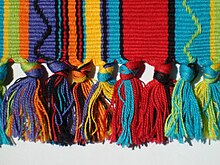Grosgrain weave


Under the rib weave is understood in the binding teaching of weaving a derivative of the plain weave , in which a longitudinal or transverse ribbed surface structure is produced.
In the case of a chain trip , also known as a crossover, the chain density, i.e. H. the number of warp threads per centimeter increased so much that the weft threads disappear completely underneath. The fabric image is determined in terms of color and material only by the warp material, the longitudinal threads. To enhance the grosgrain effect, two or more weft threads can be shot into a single shed , or a weft material can be used that is much thicker than the warp threads. In contrast to this real rep, only one weft per tie is used for fake cross rips like poplin .
In weft ribs, also known as longitudinal ribs, the fabric structure in terms of color and material is only determined by the weft material, the transverse threads. With real weft rep, this is achieved by shooting several weft threads into the shed at the same time. In the case of fake longitudinal ribs, the warp density is reduced to such an extent that the weft threads that are individually shot in per binding slip together and the warp threads disappear completely underneath. A kilim is knitted using this technique .
Rep fabric is stiff, abrasion-resistant and tear-resistant and is therefore used, for. B. used as an upholstery fabric.
literature
- Erika Arndt: Weaving manual. History, materials and techniques of hand weaving . Bern 2006, ISBN 3-258-06993-X
